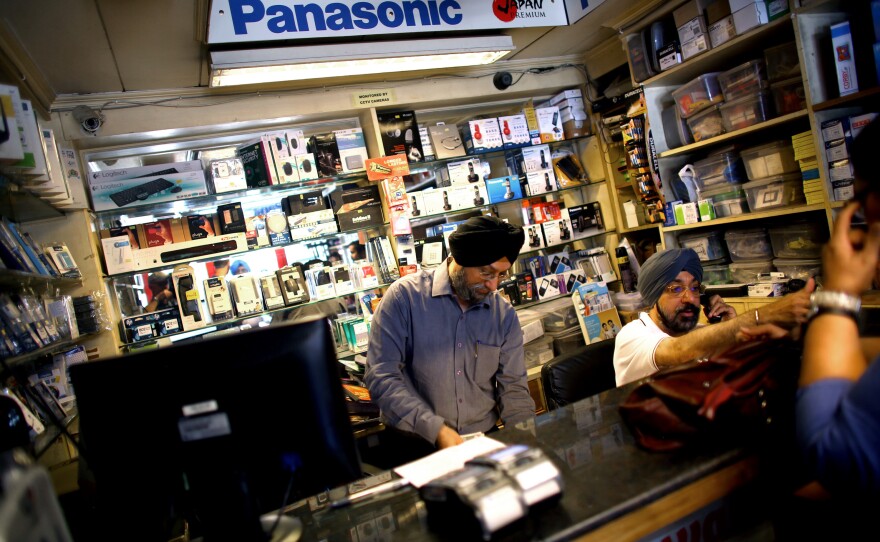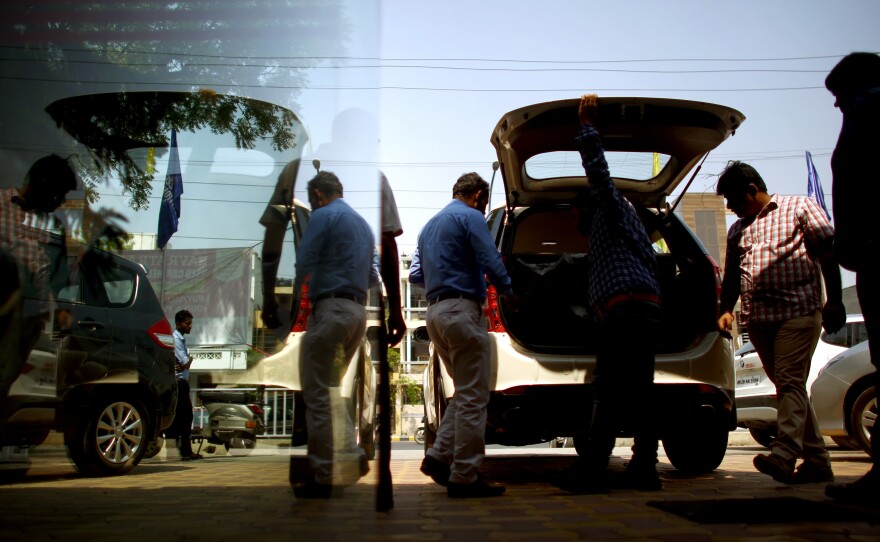




Waiting quietly in the living room of a home in an upscale New Delhi neighborhood are a dozen people of all ages — maids, security guards, construction workers, all of whom earn at most a few dollars a day. The elegant, plant-filled room is hushed except for the sound of coughing.
Over in the next room, Dr. Gita Prakash is at her dining table with a stethoscope pressed to a pregnant woman's chest. Prakash has been treating indigent patients here for 30 years, six nights a week, in the evenings after she finishes her rounds at the local hospital where she works.
Some of the people Prakash sees are the third generation from their families to seek her help. And over the decades, the kinds of problems she treats have changed.
"You know, there's a lot more of coughs and colds and allergies. And asthmas, which were not so prevalent earlier," she says.
A lot of the patients at her clinic spend all day outdoors. Restaurant delivery man Dilip Kumar Chaudhary has brought his feverish son in for treatment. I ask him what it feels like to inhale fumes in traffic day after day.
"I feel very strange. I feel very stressed," Chaudhary says. He has a hacking cough. "My whole body sweats a lot. I feel very tired."
Prakash takes care of Chaudhary's son today, but she is worried about the father, too. "I know that in two days, he'll be back with his cough," she says. "The problem is he'll have infected his son by then."
"As a doctor," I ask her, "what do you do?"
"I pray."
New Delhi has some of the most polluted air in the world, even worse than Beijing's. When President Obama came to India last February, the stories that ran during his visit warned that the president's life would be shortened by six hours — just from breathing the Indian capital's air for a few days.
Indian newspapers ran headlines saying the U.S. Embassy purchased 1,800 air purifiers before the president's arrival. Indrajit Singh, who saw a spike in sales of air filters at his own New Delhi electronics shop, says this is when Delhi's pollution problem really burst into the public consciousness.
"That's when people started thinking that, yes, it's a serious matter," he says.
In New Delhi, people feel pretty good when the air quality index, as measured by a monitor of airborne fine particulate matter at the U.S. Embassy, is below 50. Anything over 150 is considered unhealthy. The chart tops out at 500, but even so, "We've hit over 500 on this," Liam Fitzgerald, an assistant management officer at the embassy, tells me.
What does the air feel like on days like that?
"Chunky," he says.
Reecha Upadhyay, the organizer of an environmental campaign called Help Delhi Breathe, says Delhi's filthy, sometimes chunky air provides an opportunity to talk about something more abstract — climate change.
"It's a concept. It's not a reality for a lot of people," she says. "But air pollution is a reality because it's now affecting your kids, you can feel how it affects you, and it's a very tangible thing that people have in their minds and can experience."
Upadhyay and other environmentalists hope public pressure will push the government toward clean energy policies. India is the world's third-largest emitter of carbon dioxide into the atmosphere, after the U.S. and China.
Today, per person, Indians use much less energy than Americans or Chinese people. Many of its 1.2 billion-strong population live on roughly $2 a day. But what if all of those people had electricity at night, a refrigerator, a car?
With ambitious goals to improve the standard of living, and 400 million people already lacking reliable electricity, "This means we need to enhance the energy supply by four to five times what it is now," says Ajay Mathur, a climate expert who runs the Energy and Resources Institute in New Delhi. He says no matter how fast India increases its clean energy, like solar and wind, the country will probably also double its use of coal between now and 2030.
Todd Stern, who served till last month as the top U.S. envoy on climate change, says India has a steeper hill to climb than anywhere else. "There is no country, probably, with a bigger challenge — looking at the number of people, the level of their economic growth, the number of people who don't have access to electricity," he says.
The impacts of climate change would hit people in India harder than almost anywhere else in the world, making it more vulnerable to flooding and drought. "Tropical cyclones are likely to become more intense. We're also seeing that climate change is going to have an impact on the monsoon," says Richard Hewston of the global risk assessment firm Verisk Maplecroft.
His company looked at which countries around the world are most vulnerable to storms, flooding and other acts of nature. India is already at the top of the list, first in the world. Two of its biggest cities, New Delhi and Kolkata, with a combined population of more than 14 million, are on the top 10 list of global cities most vulnerable to natural hazards.
Every highly developed country in history, including the U.S., has gotten where it is in an unsustainable way — by cutting down trees, adding cars to the roads, pumping carbon into the atmosphere. If India can find a sustainable way to develop, that could be a template for the rest of the world.
In the filtered, cooled air of the U.S. Embassy in New Delhi, Ambassador Richard Verma tells me he thinks India is poised to take the lead on clean energy and climate change. Already, it has set an ambitious target of 100 gigawatts of solar energy by 2022, which would be a faster buildup than any country has managed.
"There's no other country on the planet that has set the kind of renewable targets and goals that India has. So I think the way to get there is a challenge, but India, I think, is really going to be a trailblazer in this whole area," he says.
The challenge for India is how to manage the tension between development and climate change. What happens next here could have a huge impact on the world and has the potential to write a new story on how developing countries enter the 21st century — including whether the world can alter the course on climate change or not.
India has big plans to give its people things Americans take for granted, like refrigerators and cars. In the U.S., almost 90 percent of households own a car. In India, that figure is only 6 percent. The number is growing steadily, though.
New Delhi used car salesman Deepak Sharma has conflicted feelings about all this. "Cars are increasing global warming. So I don't think it's good," he says.
Many people would be surprised to hear somebody who sells cars for a living saying cars are part of the problem. But, Sharma says, "If I'm a car seller, that means I'm also a human being, no? So I have to tell them, please use car — but as much as you can, use less."
New Delhi has been experimenting with a plan to reduce pollution by getting cars off the road. There were 8.8 million registered vehicles in Delhi in 2015, a 6 percent increase over the previous year. (In comparison, there were 7.4 million registered vehicles in Los Angeles in 2014.) For two weeks in January and April, on alternate days, you could only drive your car depending on whether the license plate ended in an odd or even number.
Used cars keep their old plates, but this means those who can afford it are looking for a workaround: another car. "If anybody has an even-numbered car, they want to buy an odd-numbered car also," says Sharma.
So the odd-even scheme, which is supposed to get cars off the street, is "not successful," Sharma says. "It's not successful because people are buying other cars."
In a South Delhi neighborhood, the Wadhwa family is grappling with this very issue. The Wadhwas are well-off by Indian standards. They own two cars. But both have even-numbered plates. And this is a Monday, when only odd-numbered cars can be on the road.
The sun hasn't even been up for two hours, and the mother, Muskan, is already exasperated.
"It's really difficult," she complains.
Mohid, the father, is about to put their 3-year-old into a taxi before he puts their 7-year-old onto his motor scooter, which is exempt from the rationing. He says if this rationing goes on, he'll buy car No. 3.
Does he think the odd-even scheme is a good idea?
"It's good if it's controlling the pollution," he says. "If it's not controlling the pollution, then it's a very bad idea."
The government has had a hard time showing that its plan did actually reduce pollution. But cars are just one small part of India's carbon footprint — one of the many things the country will have to get right to develop in a sustainable way.
Buying another car to deal with the odd-even rationing won't help with pollution, Mohid concedes. "But we have to manage our family needs. So we have to manage that also."
His 7-year-old daughter grabs her Disney backpack — she's obsessed with Frozen — and hops on the scooter with Dad.
"Did you do your homework?" he asks.
"Nope."
"Tell your teacher it was your auntie's wedding," Mohid says.
They motor off into Delhi's tangled, chaotic traffic to start their day.
Copyright 2016 NPR. To see more, visit http://www.npr.org/.






